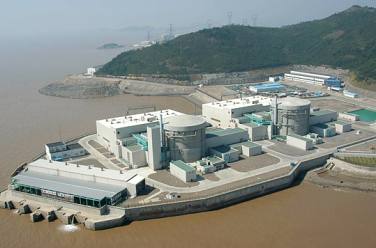Atomic Energy of Canada Ltd (AECL) is to cooperate with three Chinese organisations to assess the use of thorium fuel in Candu pressurized heavy water reactors (PHWRs).
 |
| Qinshan Phase III - soon to be fuelled by thorium? (Image: AECL) |
Canadian Consul General Nadir Patel witnessed the signing ceremony between representatives of all the organisations. The ceremony was held at the conclusion of a two-day technical seminar on Enhanced Candu 6 and thorium fuel.
"Candu nuclear technology has the potential to make a major contribution to reducing China's dependence on imported nuclear fuel resources by utilizing abundant domestic thorium resources," according to Jerry Hopwood, AECL's vice president of product development. He added, "This signing marks the initiation of an important step to demonstrate the use of thorium fuel in commercial Candu reactors."
This new agreement is phase two of a cooperation agreement signed in November 2008 that focused on demonstrating the use of uranium recovered from used nuclear fuel in a Candu reactor. The first stage of the agreement, to be completed by the end of October, is a joint feasibility study to examine the economic feasibility of the thorium proposal.
Dakuan Li, general manager of Qinshan, commented, "This is another milestone in the four-party cooperation on development, demonstration and deployment of advanced Candu thorium fuel in China."
AECL said it had investigated the use of thorium as fuel for nuclear power reactors for over 50 years, including tests in a prototype Candu power reactor in Canada, with promising results.
Two 728 MWe Candu 6 units are in operation at the Qinshan Phase III plant in China, which is owned and operated by the TQNPC. It is adjacent to the Qinshan Phase I and Qinshan Phase II plants, which comprise one and two pressurised water reactors (PWRs), respectively. Construction of Qinshan Phase III started in June 1998 with AECL as the general contractor. Qinshan 4 began commercial operation in December 2002 and Qinshan 5 in July 2003.
Thorium is more abundant than uranium and, although not fissile, it can be used as nuclear fuel because when it is irradiated with slow neutrons fissile uranium-233 is produced. This is typically achieved by using a 'blanket' of thorium around a 'seed' of uranium fuel. A thorium fuel cycle leads to the production of only very small amounts of plutonium, and is seen as being more proliferation-resistant than the uranium fuel cycle. It also has advantages over uranium fuel in terms of the radiotoxicity of the spent fuel. Thorium fuel has been studied in various countries for at least 30 years, but abundant uranium supplies have in the past lessened the need for its full development for commercial use.




_53514_33880.jpg)


_91467.jpg)





